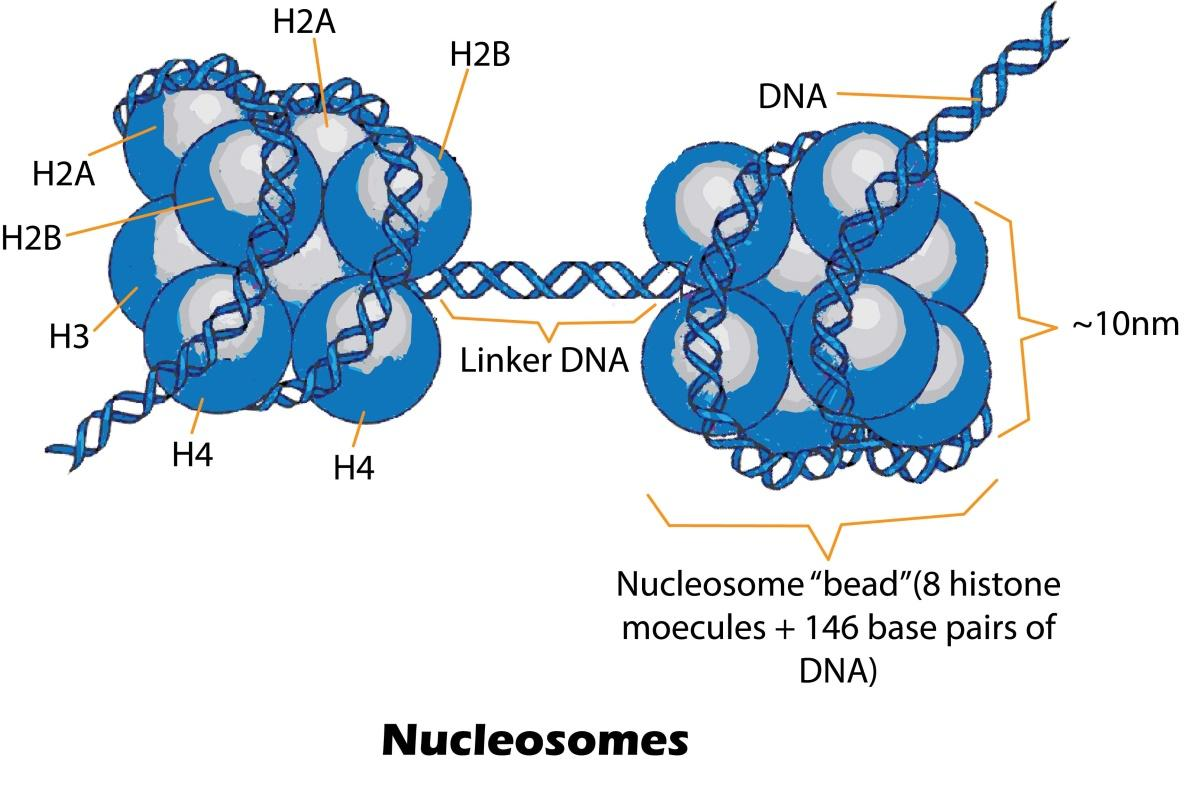
With the help of a suitable diagram describe the structure of a nucleosome.
Answer
582.6k+ views
Hint: It is a combination of DNA and histone protein. These were first shown by Woodcock in chromatin fibers in the year 1973. The nucleosomes give chromatin its-beads-on-a-string appearance under the electron microscope.
Complete answer:
The chemical composition of a chromosome is DNA and histone proteins. The DNA molecules are very long, yet they are packed with the help of positively charged histones into a smaller diameter. Histones are rich in arginine and lysine (amino acid residues), which form the core around which a double-stranded DNA fragment is wounded.
The nucleosome bead appears as a disc-shaped particle with a diameter of about 11nm. Each nucleosome bead consists of 8 histone molecules (octamer) copies. Each of these highly conserved nucleosomal histones, H2A, H2B, H3, and H4 are two in number, so it makes 8 histone molecules. These form a protein core around which a double-stranded DNA fragment (146 loose long pairs) is wounded. Each histone molecule has two parts, an uncharged hydrophobic region and a charged region having basic amino acids. Each nucleosome bead is separated from the next by a region of linker DNA which is approximately 60 base pairs long. The linker DNA plus the nucleosome bead form the entire nucleosome which therefore contains about 200 base pairs of DNA. The nucleosomes coil up tightly to create chromatin loops. The chromatin loops are then wrapped around each other, which makes a full chromosome.

Figure: The structure of nucleosomes.
Additional Information:
- The term nucleosome was given by P. Oudet in 1975.
- The histone octamer is also called a nu (v8) body.
- Nucleosome = 200 base pairs + 2 molecules each of H2A, H2B, H3, H4.
Note: The DNA is wrapped over the histone octamer of the nucleosome in a superhelical (helix shape) manner forming 1.75 turns. DNA also extends as a continuous thread from one end to another end of the nucleosome.
Complete answer:
The chemical composition of a chromosome is DNA and histone proteins. The DNA molecules are very long, yet they are packed with the help of positively charged histones into a smaller diameter. Histones are rich in arginine and lysine (amino acid residues), which form the core around which a double-stranded DNA fragment is wounded.
The nucleosome bead appears as a disc-shaped particle with a diameter of about 11nm. Each nucleosome bead consists of 8 histone molecules (octamer) copies. Each of these highly conserved nucleosomal histones, H2A, H2B, H3, and H4 are two in number, so it makes 8 histone molecules. These form a protein core around which a double-stranded DNA fragment (146 loose long pairs) is wounded. Each histone molecule has two parts, an uncharged hydrophobic region and a charged region having basic amino acids. Each nucleosome bead is separated from the next by a region of linker DNA which is approximately 60 base pairs long. The linker DNA plus the nucleosome bead form the entire nucleosome which therefore contains about 200 base pairs of DNA. The nucleosomes coil up tightly to create chromatin loops. The chromatin loops are then wrapped around each other, which makes a full chromosome.

Figure: The structure of nucleosomes.
Additional Information:
- The term nucleosome was given by P. Oudet in 1975.
- The histone octamer is also called a nu (v8) body.
- Nucleosome = 200 base pairs + 2 molecules each of H2A, H2B, H3, H4.
Note: The DNA is wrapped over the histone octamer of the nucleosome in a superhelical (helix shape) manner forming 1.75 turns. DNA also extends as a continuous thread from one end to another end of the nucleosome.
Recently Updated Pages
The number of solutions in x in 02pi for which sqrt class 12 maths CBSE

Write any two methods of preparation of phenol Give class 12 chemistry CBSE

Differentiate between action potential and resting class 12 biology CBSE

Two plane mirrors arranged at right angles to each class 12 physics CBSE

Which of the following molecules is are chiral A I class 12 chemistry CBSE

Name different types of neurons and give one function class 12 biology CBSE

Trending doubts
Which are the Top 10 Largest Countries of the World?

What are the major means of transport Explain each class 12 social science CBSE

Draw a labelled sketch of the human eye class 12 physics CBSE

Differentiate between insitu conservation and exsitu class 12 biology CBSE

The computer jargonwwww stands for Aworld wide web class 12 physics CBSE

State the principle of an ac generator and explain class 12 physics CBSE




